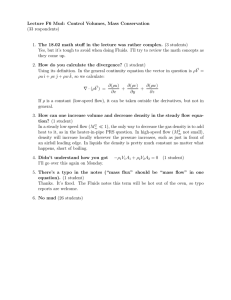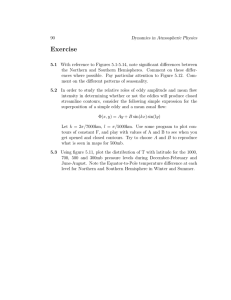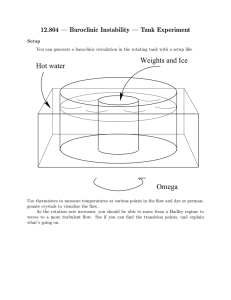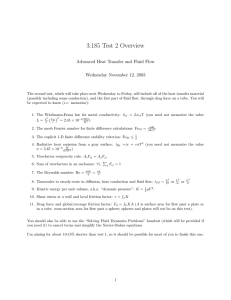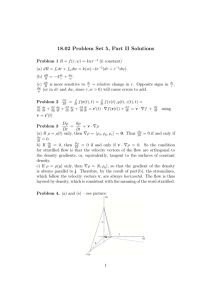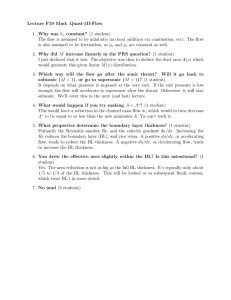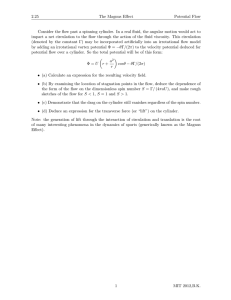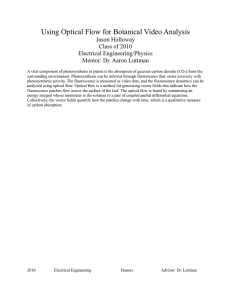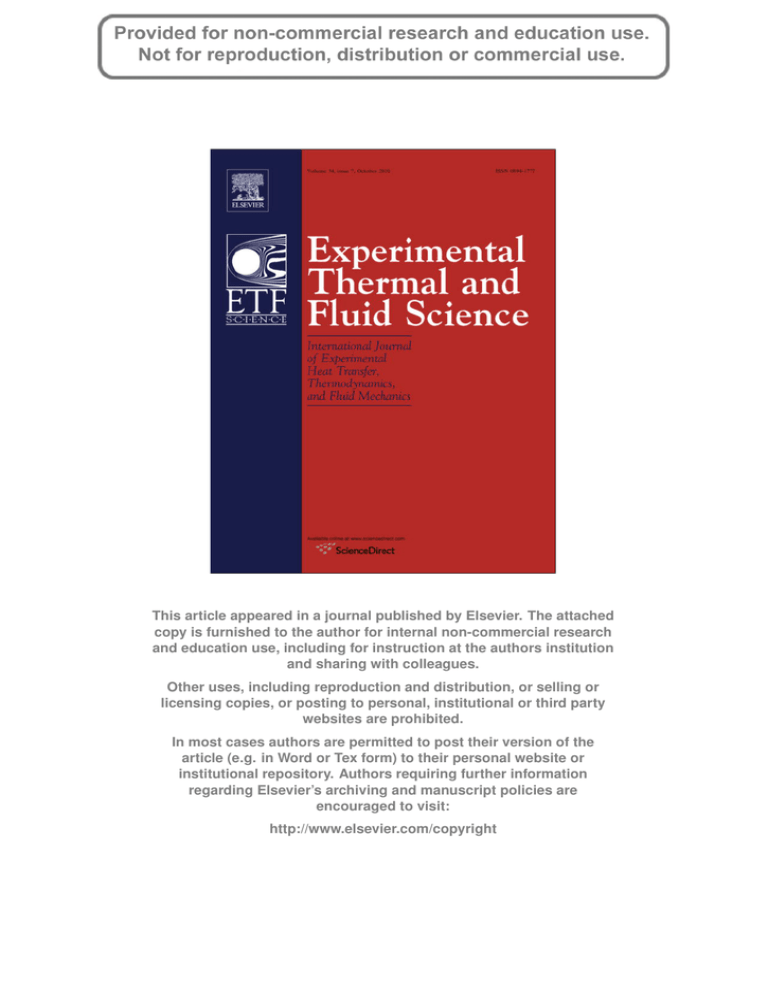
This article appeared in a journal published by Elsevier. The attached
copy is furnished to the author for internal non-commercial research
and education use, including for instruction at the authors institution
and sharing with colleagues.
Other uses, including reproduction and distribution, or selling or
licensing copies, or posting to personal, institutional or third party
websites are prohibited.
In most cases authors are permitted to post their version of the
article (e.g. in Word or Tex form) to their personal website or
institutional repository. Authors requiring further information
regarding Elsevier’s archiving and manuscript policies are
encouraged to visit:
http://www.elsevier.com/copyright
Author's personal copy
Experimental Thermal and Fluid Science 34 (2010) 813–826
Contents lists available at ScienceDirect
Experimental Thermal and Fluid Science
journal homepage: www.elsevier.com/locate/etfs
The effects of surface tension on flooding in counter-current two-phase flow
in an inclined tube
Deendarlianto a,d,*, Akiharu Ousaka b, Indarto a, Akira Kariyasaki c, Dirk Lucas d, Karen Vierow e,
Christophe Vallee d, Kevin Hogan e
a
Department of Mechanical & Industrial Engineering, Faculty of Engineering, Gadjah Mada University, Jalan Grafika No.2 Yogyakarta 55281, Indonesia
Department of Mechanical Engineering, The University of Tokushima, 2-1 Minami Josanjima, Tokushima 770-8506, Japan
Department of Chemical Engineering, Fukuoka University, 8-19-1, Jyonan-ku, Fukuoka 814-0180, Japan
d
Forschungszentrum Dresden-Rossendorf e.V., Institute of Safety Research, P.O. Box 510 119, D-01314 Dresden, Germany
e
Department of Nuclear Engineering Texas A&M University, 129 Zachry Engineering Center, 3133 TAMU College Station, TX 77843-3133, USA
b
c
a r t i c l e
i n f o
Article history:
Received 5 August 2009
Received in revised form 26 January 2010
Accepted 27 January 2010
Keywords:
Counter-current two-phase flow
Flooding
Inclined tube
Surface tension
Flooding mechanisms
a b s t r a c t
The purpose of the present study is to investigate the effects of surface tension on flooding phenomena in
counter-current two-phase flow in an inclined tube. Previous studies by other researchers have shown
that surface tension has a stabilizing effect on the falling liquid film under certain conditions and a destabilizing or unclear trend under other conditions. Experimental results are reported herein for air–water
systems in which a surfactant has been added to vary the liquid surface tension without altering other
liquid properties. The flooding section is a tube of 16 mm in inner diameter and 1.1 m length, inclined
at 30–60° from horizontal. The flooding mechanisms were observed by using two high-speed video cameras and by measuring the time variation of liquid hold-up along the test tube. The results show that
effects of surface tension are significant. The gas velocity needed to induce flooding is lower for a lower
surface tension. There was no upward motion of the air–water interfacial waves upon flooding occurrence, even for lower a surface tension. Observations on the liquid film behavior after flooding occurred
suggest that the entrainment of liquid droplets plays an important role in the upward transport of liquid.
Finally, an empirical correlation for flooding velocities is proposed that includes functional dependencies
on surface tension and tube inclination.
Ó 2010 Elsevier Inc. All rights reserved.
1. Introduction
The current work focuses on the dependence of flooding on surface tension for counter-current liquid–gas flow in tubes of various
inclinations. Flooding can be defined as the onset of flow reversal
of the liquid component which results in an upward co-current
flow. While studies by other researchers have indicated significant
surface tension effects on the conditions for flooding occurrence,
the results have not been consistent. The current work aims to extend the understanding of the physics of the relationship between
surface tension and flooding phenomena by clarifying the flooding
mechanisms under various values of surface tension for a range of
tube inclinations. Such understanding is important because the
surface tension varies in applications from that of air–water at
room temperature. Industrial applications employ various fluids
that have different thermophysical properties. Steam and water
* Corresponding author. Address: Forschungszentrum Dresden-Rossendorf e.V.,
Institute of Safety Research, P.O. Box 510 119, D-01314 Dresden, Germany. Tel.: +49
351 260 2425.
E-mail addresses: d.deen@fzd.de, deendarlianto@ugm.ac.id ( Deendarlianto).
0894-1777/$ - see front matter Ó 2010 Elsevier Inc. All rights reserved.
doi:10.1016/j.expthermflusci.2010.01.010
in nuclear reactors at higher temperature and pressure will also
have a greatly different surface tension. A mechanistic understanding of the role of surface tension will allow for more accurate analysis techniques to promote extended operation and improved
safety.
Counter-current two-phase flow in vertical tubes has many
applications in a diverse range of process industries. The phenomenon of flooding is of considerable technological importance, as
flooding can be a limiting factor in the operation of equipment.
For example, in a pressurized water reactor (PWR), the countercurrent flow of steam (upward) and cold water (downward) may
take place in vertical channels when the emergency core cooling
(ECC) water is injected into the reactor vessel. This leads to complex processes including the condensation of steam due to the
introduction of cold water into the reactor core. Most importantly,
upward steam flow may prevent sufficient cooling of reactor components by the ECC water.
Flooding in inclined channels can also potentially occur in a variety of situations, such as the pressurizer surge line of a PWR. The
pressurizer surge line is typically comprised of several sections with
various inclination angles. Under certain accident conditions,
Author's personal copy
814
Deendarlianto et al. / Experimental Thermal and Fluid Science 34 (2010) 813–826
Nomenclature
C
D
g
JG
JG,f
JG,do
JL
JL,D
JK
KuG
L
constant in Eqs. (6)–(8) (–)
tube inner diameter (m)
gravitational acceleration (m/s2)
superficial gas velocity (m/s)
superficial gas velocity at flooding (m/s)
superficial gas velocity at complete dry out (m/s)
inlet superficial liquid velocity (m/s)
discharged superficial liquid velocity (m/s)
Wallis dimensionless number of superficial velocity (–)
Kutateledze dimensionless number of the gas phase (–)
tube length (m)
counter-current flow takes place in the surge line with liquid flowing
down from the pressurizer vessel and steam flowing up from the hot
leg of the reactor pressure vessel. The steam venting rate as well as
the liquid draining rate may affect the ECC actuation [20].
Chung et al. [3] reported that the surface tension had a stabilizing effect on flooding, i.e. the flooding gas velocity was lower for a
lower surface tension. English et al. [7] found the same trend. However, Kamei et al. [10] found the opposite trend. On the other hand,
Suzuki and Ueda [19] reported that the effect of surface tension
was complicated and the flooding gas velocity took its maximum
value at a surface tension close to 5.0 102 N/m.
While the above studies were performed in vertical tubes, little
work has been reported on the effects of surface tension in inclined
tubes. Barnea et al. [1] studied air–water counter-current twophase flow in an inclined tube for a wide range of inclinations
(1–90° from horizontal). They reported that the gas velocities upon
flooding occurrence increase and then decrease as the tube inclination is changed from horizontal to vertical. Zapke and Kroger [23]
investigated the effect of gas and liquid properties upon flooding in
inclined tubes, but they only examined a tube inclination of 60°.
Next Mouza et al. [15] examined the incipient flooding in inclined
tubes of small diameter. In the conclusion of their study, it is suggested that additional data is needed in order to explain the effects
of liquids and gases properties on flooding and to assess the significance of dimensionless numbers employed for general correlations. A more detailed survey of the literature for flooding in
inclined tubes was performed and a simplified analytical model
to predict the optimum channel inclination angle for gas venting
has been proposed by Liao and Vierow [12].
Recently, a subset of the authors [6] observed the liquid film
behavior upon flooding of an adiabatic counter-current two-phase
flow in an inclined tube by using the combination of time variation
measurements of liquid hold-up taken along the tube and visual
observation. The liquid hold-up is the fraction of the tube cross sectional area occupied by liquid. This work provides the basis for
studies of the effects of surface tension in inclined tubes. They reported that there are two prevalent locations of flooding in an inclined tube which are associated with distinct conditions: ‘‘lower
flooding” and ‘‘upper flooding”, respectively. The terms lower
flooding and upper flooding indicate whether flooding is initiated
at the lower or the upper locus of the test section.
Lower flooding occurred at lower liquid flow rate and high tube
inclination angle, and the breakdown of the waves at the air–liquid
interface occurred in the lower part of the tube (x/L ranged from
0.0 to 0.5). Here, L is the total tube length and x is the distance from
liquid outlet. The breakdown of waves is considered as the point of
flooding because all the liquid supplied cannot flow down
smoothly. It is initiated by the increase of the wave height, in
which the wave formation is begun from the upper part of the test
tube (x/L ffi unity). The wave height increases with the downward
m
t
V 0d
V 0G
constant in Eq. (6) (–)
time (s)
dimensionless discharged liquid flow rate (–)
dimensionless gas flow rate (–)
Greek Letter
h
inclination angle from horizontal (deg)
g
liquid hold-up (–)
qk
liquid and gas density (kg/m3)
r
surface tension (N/m)
l
static viscosity (Pa s)
movement. It is disrupted by the air flow when the wave height
reaches a certain height in counter-current flow. Liquid droplets
arise at nearly the same time of the breakdown of the wave and
there is no upward motion in the liquid film.
On the other hand, upper flooding occurred at higher liquid flow
rate and low tube inclination. It is initiated by the formation of low
void fraction region in the upper part of the test tube (x/L ffi unity),
in which the maximum of liquid hold-up is 1.0. For small tube
diameters, the liquid slug can completely bridge the cross sectional
area of the test tube. It moves downward for a short distance and is
broken up by air flow in the upper part of the test tube (x/L from
0.5 to 1.0). Furthermore, it was noticed that there was no reverse
motion of the liquid film at the point of flooding during the occurrence of either lower flooding or upper flooding.
The objective of the current work is to carry out a series of
flooding measurements for different surface tension values, making detailed observations in each case, to clarify the governing phenomena for flooding and the post-flooding conditions of partial
liquid delivery and zero penetration. In this paper, the experimental results of instantaneous liquid hold-up at the point of flooding
and afterwards, under a single liquid flow rate, will be presented
first for a range of surface tension values. This data will reveal
information on the wave growth and the propagation direction of
the liquid film. The philosophy of upper flooding and lower flooding, as proposed in the previous papers, will be extended. Next, the
effect of surface tension on the gas velocity at flooding and possible
explanations will be presented. The effect of surface tension on
flow patterns occurring after flooding, namely partial liquid delivery and zero penetration, are also experimentally examined. Finally, an empirical correlation for the onset of flooding gas velocity
that incorporates the effect of liquid surface tension is proposed.
2. Experimental apparatus and procedures
The details of the experimental apparatus and procedure used
in the present study were described in the previous papers
[5,6,16] and only the main features are presented here. The test
section consisted of a test tube having total length of 1.1 m as
shown in Fig. 1. Air was fed from a compressor to the lower end
of the inclined tube and flowed upward through the test section
to a separator. Liquid entered from a porous section and flowed
downward in the tube. The inlet liquid flow rate and the discharged liquid flow rate were both measured. To ensure accuracy,
the liquid flow rate was confirmed by collecting the liquid discharged from the lower test tube outlet over a fixed period of time,
and the measurements were time-averaged and shown to have
good repeatability.
The test tube was made of transparent acrylic resin with an inner diameter of 16 mm. The liquid inlet consisted of a porous sec-
Author's personal copy
815
Deendarlianto et al. / Experimental Thermal and Fluid Science 34 (2010) 813–826
Fig. 1. Schematic diagram of experimental apparatus.
Fig. 2. Liquid and air inlets [5].
tion of tube to insure that the liquid film flow was uniform at the
point of entry. The air entrance was made of acrylic resin, providing a conical inlet passage to avoid turbulence effects in this section. The schematic drawings of the liquid inlet and the air
entrance are shown respectively in Fig. 2a and b.
The experiments were performed using air and three test liquids, i.e., water and aqueous oleic acid natrium solution of two differing concentrations, thus providing test liquids with a variation
of surface tension rL. Surface tension was measured using an automatic surface tension measurement system. This system uses a
photoelectric sensor to detect a falling drop under the capillary
tip. The liquid surface tension is calculated from the volume of
the falling drop. The details of the experimental apparatus, principle and the measurement system can be found in [14]. The liquid
temperatures were approximately 20 °C and fluid properties are given in Table 1.
In the present study, we used oleic acid natrium to decrease the
surface tension because it is a powerful surfactant which, when
used in low concentrations (0.1 wt.%), decreases the surface tension to 0.031 N/m without affecting other liquid properties. A typical measurement of the relationship between the surface tension
and the weight percentage of oleic acid natrium is shown in
Fig. 3. In the present study, the measurements of surface tension
Table 1
Physical properties of liquid used in the experiment (at 20 °C).
Liquid
qL (kg/m3)
rL (N/m)
lL (Pa s)
Water (S72)
0.02 wt.% oleic acid natrium
solution (S72)
0.05 wt.% oleic acid natrium
solution (S34)
998.2
998.2
0.072
0.051
10.03 104
10.03 104
998.2
0.034
10.03 104
qL: density, rL: surface tension and lL: static viscosity.
were done both at the inlet and the exit of test tube, before and
after the experiment. As a result the values of surface tension were
almost the same. This indicates the concentration and distribution
of surfactant in the test fluids are almost uniform. Consequently,
the effect of dynamic surface tension in our experiments can be
neglected.
The interfacial behavior of the liquid film was investigated by
using two high-speed video cameras. The pictures were taken at
different locations along the tube at 240 frames per second and
at a shutter speed of 1/10,000 s. During this experimental study,
two cameras were used, one at the liquid inlet and another at
the liquid outlet.
Author's personal copy
816
Deendarlianto et al. / Experimental Thermal and Fluid Science 34 (2010) 813–826
3. Results and discussion
0.1
S72
3.1. Flow behavior in flooding condition
σ [ N/m ]
S34
0.05
S51
0.03
0.01
3.1.1. Low liquid flow rate
Fig. 4 shows the comparison of the time variation of liquid holdup for each test liquid at low liquid flow rate, JL = 0.03 m/s for
example. The tube inclination was 30°. In the figure, (a), (b) and
(c) correspond to the cases of S72, S51 and S34 respectively. In
the figure, JG was taken as the superficial gas velocity at the initiation of flooding of each case. In these tests, the fluids were in a
stratified flow pattern. From Fig. 4a, it is noted that:
0.0 1
0.03
0.1
0.3
1
1.2
Wt% of Oleic Acid Natrium [%]
Fig. 3. Surface tension vs. weight percentage of oleic acid natrium (at 20 °C).
The instantaneous local liquid hold-up was detected by using
the constant electric current method (CECM). The liquid hold-up
is the fraction of the tube cross sectional area occupied by liquid.
This method works on the basis of the difference in the electric
resistance between the gas and the liquid phases. It was originally
developed by Fukano [8] to observe the interfacial structure in cocurrent gas–liquid two-phase upward flow. Furthermore, it was
used by the authors to investigate the liquid film behavior during
adiabatic air–water counter-current two-phase flow in an inclined
tube [6]. In the present experiment, we used six liquid hold-up
sensors arranged with an axial spacing of 100 mm. Each sensor
consists of a pair of brass electrodes, 1 mm in thickness, 5 mm
apart from each other, mounted flush with the inner surface of
the test tube. Since the electrodes were mounted flush with the
surface of the channel, two-phase flow was not disturbed by the
electrodes. The output signals from the sensors were sent respectively through the floating amplifier with high input impedance
to a personal computer via an A/D converter. The liquid hold-up
data were acquired at 1.0 kHz. Further details of the experimental
apparatus, principle and the measurement system can be found in
Fukano [8,9].
In the present experiment, the liquid flow rate was kept constant and the airflow rate was increased in small increments. Prior
to changing to the next air flow rate, at least a few minutes was allowed to elapse to ensure that the flow pattern was in a steady
state. Next, the liquid hold-up, pressure gradient and discharged liquid flow rate were measured. Flooding was defined as the limit of
stability of the counter-current flow, indicated by the maximum
airflow rate at which the discharged liquid flow rate is equal to
the inlet liquid flow rate. Flooding is commonly referred to as the
point of transition between counter-current flow and partial
delivery.
The experimental conditions were as follows: tube inclinations:
30°, 45° and 60° from horizontal; the range of superficial liquid
velocity: JL = 0.03–0.32 m/s and the superficial gas velocity;
JG = 0.0–14 m/s.
To simplify the explanation in this paper, we have used some
abbreviations for the test liquids on the basis of their surface tensions. The abbreviations in this paper are as follows: S72: Air–
water (static surface tension rL = 0.072 N/m), S51: Air–0.02 wt.%
aqueous oleic acid natrium solution (rL = 0.051 N/m) and S34:
Air–0.05 wt.% aqueous oleic acid natrium solution (rL = 0.034 N/
m). Furthermore, the abbreviations for the flow characteristics
are as follows: W: wave, LW: large wave, BW: breakdown of the
wave and RW: ring-type of the wave. Here, LW corresponds to
the blockage of the wave in the test tube, whereas the maximum
liquid hold-up of the wave (W) is equal to 1.0.
1. The time signature of W at x/L = 0.75 and t 0.03 s indicates
that a wave is formed near the top of the test tube (x/L ffi unity).
It then propagates downwards and it is clearly seen from the
figure that waves shift to the lower right. Next the liquid
hold-up of this wave increases from x/L = 0.75–0.25, indicating
that the wave height increases with downward movement. This
is behavior that may precede flooding.
2. Next, the breakdown of the wave (BW) is observed to occur at x/
L = 0.35 and t 1.64 s. In this period, the corresponding wave
recorded by the sensor at x/L = 0.35 and t 1.64 s, the height
of which is noticeably higher at x/L = 0.45, seems to be disappearing by the time it reaches the sensor at x/L = 0.35 and
t 1.64 s. Consequently, the local liquid hold-up at this wave
is smaller than the corresponding wave recorded by the previous sensor (x/L = 0.45 and t 1.61 s). The occurrence of BW
under this flow condition is considered to be flooding because
all the liquid supplied cannot flow down smoothly [6].
The process of the wave breakdown under this flow condition
included the formation of roll wave and the development of entrained liquid droplets as reported in the previous paper [6] is
shown in Fig. 5.
Despite the decrease of surface tension to 0.051 and 0.034 N/m
as shown in Fig. 4b and c, the phenomena are similar. The waves
are initiated at the top of the test tube and propagate downwards,
in which the maximum wave height increases as the waves move
downstream. Next, the BW occurs in the lower part of test tube (x/L
ranges from 0.25 to 0.45). From Fig. 4a–c, it is revealed that associated waves continue to travel downward BW, signifying that
there is no upward motion of the wave even for smaller surface
tension. In addition, there is no blockage process in the tube, as
the maximum liquid hold-up is smaller than 1.0.
According to the previous paper [6] with higher surface tension,
lower flooding occurs under this flow condition. In the current
experiments, BW occurs in the lower half of the tube. From the
above results, it is concluded that the surface tension does not
change the flooding location at low liquid flow rate in an inclined
tube.
As the airflow is increased further, the discharged liquid flow
rate becomes smaller than the inlet liquid flow rate, and the chaotic regions, i.e. the generation and the breakdown of the waves
extend further along the length of the tube. Evidence is shown
clearly in Fig. 6, in which (a) and (b) correspond to the cases of
S72 and S51 respectively. The discharged liquid flow rate under
the flow conditions in Fig. 6a and b are 89% and 91% of the inlet liquid flow rate. Close inspection of these figures reveal that there is
no flow reversal of waves under these flow conditions, because the
wave’s signs of the liquid hold-up signal always shift to the lower
right. This poses the question, how does the discharge liquid flow
rate become smaller? From visual observation, it can be seen that
the upward transport of liquid corresponds to the carry-over of liquid in the form of entrained droplets. After flooding, the droplet
Author's personal copy
817
Deendarlianto et al. / Experimental Thermal and Fluid Science 34 (2010) 813–826
0.4
W
W
W
W
W
x/L
W
0.75
0.0 0.4
0.65
0.4 0.0
0.55
η
0.0 0.4
0.45
0.4 0.0
BW
BW
0.35
0.0 0.4
BW
BW
0
1
2
BW
BW
0.0
0.25
4
3
time [s]
5
6
(a) S72 (JL=0.03 m/s, JG=8.29 m/s and θ=30°).
0.3
W
W
x/L
W
W
W
0.75
0.00.3
η [−]
0.30.0
0.65
W
0.55
0.00.3
BW
BW
BW
0.45
0.3 0.0
BW
BW
BW
BW
0.35
0.0 0.3
BW
0.0
4
5
BW
W
BW
0.25
6
7
time [s]
8
9
10
(b) S51 (JL=0.03 m/s, JG=6.64 m/s and θ=30°).
0.2
W
W
W
W
x/L
W
W
W
0.75
0.0 0.2
0.65
η [-]
0.2 0.0
0.55
0.0 0.2
0.45
0.2 0.0
BW
BW
0.0 0.2
BW
BW
BW
BW
BW
BW
0.25
0.0
0.0
0.35
W
0.5
1.0
1.5
2.0
time [s]
2.5
3.0
3.5
4.0
(c) S34 (JL=0.03 m/s, JG=5.21 m/s and θ=30°).
Fig. 4. Comparison of time variation of liquid hold-up at flooding at low liquid flow rate for each surface tension (JL = 0.03 m/s, h = 30° and L = 1.1 m).
flux increases as the gas flow rate increases, making the discharged
liquid flow rate decrease gradually. The examples of the interfacial
behavior of S72 taken at x/L ffi 0.25 under these flow conditions are
shown in Fig. 7. In the figure, the occurrence of the droplet as a result of the breakdown of the wave can also be seen further. The result obtained agrees well with that of Celata et al. [2] who reported
that the entrainment effect can completely prevent the liquid from
falling down in inclined tubes. From the above results, it is noticed
that the flow behavior after flooding at low liquid flow rate does
not also fundamentally change if the surface tension is changed
from 0.072 to 0.034 N/m.
3.1.2. High liquid flow rate
Fig. 8 shows the flow phenomena at flooding at JL = 0.25 m/s, in
which (a), (b) and (c) correspond to the cases of S72, S51 and S34
respectively. This represents the flow phenomena at high liquid
flow rate. From Fig. 8a, the important characteristics’ can be described as follows:
1. A large wave, marked as LW (the liquid hold-up is about 1.0),
is detected occasionally at x/L = 0.75 and t 1.9 s. This large
wave blocks the whole cross section of the test tube. It is
broken up by the airflow at x/L = 0.65 as indicated, BW and
Author's personal copy
818
Deendarlianto et al. / Experimental Thermal and Fluid Science 34 (2010) 813–826
Fig. 5. Breakdown of the wave at flooding obtained at x/L ffi 0.25 (S72, JL = 0.03 m/s, JG = 8.29 m/s, h = 30° and L = 1.1 m).
0.6
W
W
x/L
W
W
0.75
0.0 0.6
BW
0.65
η [−]
0.6 0.0
W
BW
BW
0.55
0.0 0.6
W
0.45
0.6 0.0
0.35
BW
0.0 0.6
BW
0.25
0.0
0
1
2
3
time [s]
4
5
6
(a) S72 (JL=0.03 m/s, JG=9.21 m/s and θ=30°).
0.3
W
x/L
W
0.75
0.0 0.3
BW
0.65
η
0.3 0.0
0.55
0.0 0.3
BW
BW
0.45
0.3 0.0
BW
BW
W
W
0.35
0.0 0.3
0.25
0.0
2
3
4
5
time [s]
6
7
8
(b) S51 (JL=0.03 m/s, JG=7.64 m/s, and θ=30°).
Fig. 6. Time variation of liquid hold-up after the flooding.
produces smaller waves that move downward along the tube
without the reversal motion of the wave. The sequence picture of the wave breakdown under this flow condition
obtained near the liquid inlet is shown in Fig. 9. However,
in the lower part of the tube the liquid flow flows downwards normally without any broken down of the wave
(BW) as shown in Fig. 10. The above results indicate that
the flooding mechanism under this flow condition is upper
flooding, initiated by the sudden formation and the breaking
down of a large wave that completely blocks the whole cross
section of the test tube in the upper part [6].
With decrease of surface tension to S51 and S34, the flooding
mechanism changes drastically as given respectively in Fig. 8b
and c. In comparison with Fig. 8a where S72 is the test liquid,
the following is noteworthy:
Author's personal copy
Deendarlianto et al. / Experimental Thermal and Fluid Science 34 (2010) 813–826
819
Fig. 7. Interfacial behavior of liquid film after the flooding taken at x/L ffi 0.25 (S72, JL = 0.03 m/s, JG = 9.21 m/s, h = 30° and L = 1.1 m).
1. Wave formation begins at the top of the test tube. Next, the
breakdown of the wave (BW) is observed to occur in the lower
part of the test section. In the present study, the location of BW
ranged from x/L ffi 0.25 to 0.45. Next, the corresponding wave
always shifts to the lower right even after the BW, indicating
there is no occurrence of upward motion of the wave at the
onset of flooding. Evidence is shown clearly in Fig. 8b and c.
At the upper part of the test tube the wave flows downwards
normally without the blockage process, and is similar to the
flow configuration seen before flooding. Evidence is shown in
the interfacial behavior of S72 in Fig. 10.
2. The blockage process caused by a large wave, found in the case
of S72, did not occur in the cases of S51 and S34. This result
indicates that at high liquid flow rate the flooding mechanism
changes from upper flooding to lower flooding as the surface
tension decreases. The possible reason is due to differences of
interfacial behavior of the liquid film near the liquid inlet
among the liquids tested. In the case of S72, standing waves
with short wave length were observed at low gas flow rate.
An increase in the gas flow rate causes further wave growth
and blockage in the upper part of test tube. On the other hand,
the standing waves disappeared when S51 and S34 were used.
Here the formation of ring-type waves is observed near the
liquid inlet. This wave type is shown in Fig. 11, in which it is
marked as RW. The waves extend 360° around the inner surface
of the tube. This ring-type wave is maintained for some distance
(10–18 cm) and the liquid film then quickly drains down the
wall of the tube, converging at the bottom of the tube to form
a stratified wavy layer. The maximum of this wave height
increases with downward movement. It will be broken by gas
flow at the lower part of the tube if it reaches the certain value
of the wave height in counter-current two-phase flow. This
result is partly agreement with Mouza et al. [15] who examined
the physical properties effect on the incipient of flooding in
inclined tubes. They reported that the lower surface tension
facilitates lateral liquid spreading and the formation of the
waves. Lateral spreading of liquid at flooding appears to take
place but the upward moving waves are rather asymmetric
with more liquid at the tube bottom. The occurrence of this
ring-type of the wave in the cases of lower surface tension is
also recorded visually in our experiment, but the upward moving wave at the bottom was not observed. The use of visual
observation only in their experiment may lead to the different
conclusion. The sketches of interfacial behavior of the liquid
film for test liquids are given in Fig. 12.
Fig. 13 shows the comparison of time variation of liquid hold-up
after flooding at high liquid flow rate. The flow conditions were
JL = 0.24 m/s, JG = 6.63 m/s and h = 30°. Analysis of this figure is
needed in order to determine the upward transport method of liquid film and the effect of surface tension. Close observation of
the figures reveals that there is no flow reversal of waves under
this flow condition even though the surface tension is decreased,
whereas the corresponding wave shifts to lower right. Next, the
chaotic region such as the generation and the breakdown of waves
encompasses the total length of the test tube. Visual observations
reveal that the entrainment of liquid droplets occurs along the
tube. From the results, it is concluded that the entrainment of liquid droplets plays an important role in the upward transport of
the liquid film, and there is no effect of surface tension.
The flooding locus represented by the wave breakdown locations upon flooding using the visual observations and the analysis
of time variation of liquid hold-up are summarized in Fig. 14, in
which (a), (b) and (c) correspond to the cases of h = 30°, 45° and
60° respectively. In most cases, as the liquid flow rate is increased,
the flooding locus moves to the upper part of the tube length. The
flooding location moves to the lower part of the tube as the surface
tension is decreased. In addition, the locus of wave breakdown
moves to the lower part of the tube as the tube inclination increases for all test liquids. This result agrees well with that of
Deendarlianto et al. [6] who reported the same trend in the longer
tube (2.2 m).
3.2. Fluid characteristics in flooded condition
The experimental results of discharged liquid flow rate are presented in Figs. 15–17, in which (a), (b) and (c) correspond to the
cases of h = 30°, 45° and 60° respectively. In the figures, the liquid
flow rate collected at the lower end of test tube, expressed as the
discharged superficial liquid velocity, JL,D, is plotted vs. the superficial gas velocity, JG. Flooding is marked by the arrows. The point in
which the discharged superficial liquid velocity becomes zero is
defined as the zero liquid penetration, marked as ZP in the figures.
Furthermore, the region between flooding and ZP is defined as the
partial delivery region.
From the figures it is revealed that the measured discharged liquid flow rate was identical to the inlet liquid flow rate when the
flow condition was not flooding or post-flooding (partial liquid
delivery or zero penetration). Next the discharged superficial liquid
velocities after flooding decrease gradually and the shapes of the
curves are independent of the inlet liquid flow rate. Our calculation
confirmed that the maximum reduction in the discharged
liquid
DJ
in the parflow rate as the increase of superficial gas velocity DJL;D
G
tial delivery region was 10.6%. In addition, the trend is similar to all
test liquid and tube inclination. This result agrees well with that
obtained by Zabaras and Dukler [22] and Lacy and Dukler [11]
who showed a gradual decrease in the downward flow rate when
the air flow rate was increased beyond the flooding point. On the
other hand, this is contradictory to the obtained result by Clift
et al. [4] who performed the experimental study on flooding in
wetted wall columns. They reported that the down flow rate drops
to a value which is sometimes as low as a fifth of down flow imme-
Author's personal copy
820
Deendarlianto et al. / Experimental Thermal and Fluid Science 34 (2010) 813–826
1.0
W
x/L
LW
LW
LW
0.75
0.0 1.0
BW
BW
BW
0.65
1.00.0
BW
W
BW
BW
0.55
η [−]
0.0 1.0
W
W
W
0.45
1.00.0
W
W
0.35
0.01.0
W
W
0.25
0.0
0
1
2
3
time [s]
4
5
6
(a) S72 (JL=0.25 m/s, JG=2.07 m/s and θ=30°).
0.5
W
W
W
W
W
W
x/L
W
0.75
0.00.5
0.65
η [−]
0.50.0
0.55
0.00.5
BW
0.50.0
BW
BW
0.45
W
BW
0.35
0.00.5
BW
0.0
4
BW
5
BW
BW
0.25
6
time [s]
7
8
(b) S51 (JL=0.25 m/s, JG=1.24 m/s and θ=30°).
0.3
W
W
W
W
W
W
W
W
W
W
0.75
0.0 0.3
0.65
0.3 0.0
η [−]
x/L
0.55
0.0 0.3
BW
0.45
0.30.0
BW
BW
BW
0.35
0.0 0.3
BW
BW
W
W
0.25
0.0
6
7
9
8
time [s]
10
(c) S34 (JL=0.25 m/s, JG= 0.83 m/s and θ=30°).
Fig. 8. Comparison of time variation of liquid hold-up at flooding at high liquid flow rate for each surface tension (JL = 0.03 m/s and h = 30°).
diately before flooding. This may be due to the difference in tube
diameter, tube orientation and upward transport method of liquid
film. In the present study, we used an inclined tube of 16 mm ID
while Clift et al. used a vertical tube of 31.75 mm ID The difference
of tube inner diameter affects the upward transport of liquid film
[18]. In the present study, it was found that the entrainment of liquid droplets is the primary mechanism for upward flow; while
Clift et al. found that the carry up of a liquid slug dominates.
Maharudrayya and Jayanti [13] studied the discharged liquid
flow rate behavior in the partial delivery region in vertical pipes.
They proposed the dimensionless numbers to correlate them in
terms of dimensionless discharged liquid flow rate, V 0d and dimensionless air flow rate, V 0G defined, respectively, as
V 0d ¼
J L;D
JL
ð1Þ
Author's personal copy
Deendarlianto et al. / Experimental Thermal and Fluid Science 34 (2010) 813–826
821
Fig. 9. Interfacial behavior at flooding of S72 at high liquid flow rate obtained at x/L ffi 0.90 (JL = 0.25 m/s, JG = 2.07 m/s and h = 30°).
Fig. 10. Interfacial behavior at flooding of S72 at high liquid flow rate obtained at x/L ffi 0.08 (JL = 0.25 m/s, JG = 2.07 m/s, h = 30° and L = 1.1 m).
Fig. 11. Interfacial behavior of S51 at flooding obtained near the liquid inlet (JL = 0.25 m/s, JG = 1.24 m/s, h = 30° and L = 1.1 m).
V 0G ¼
J G J G;f
J G;do J G;f
ð2Þ
where JG,f is the superficial gas velocity at flooding and JG,do is the
superficial gas velocity at complete dry out. They recommends that
Author's personal copy
822
Deendarlianto et al. / Experimental Thermal and Fluid Science 34 (2010) 813–826
Fig. 12. Sketches of interfacial behavior of the test liquids near the liquid inlet (JL = 0.25 m/s and h = 30°).
0.2
W
W
W
W
W
W
x/L
W
0.75
0.00.2
BW
0.65
0.20.0
η [−]
BW
W
BW
0.55
0.00.2
BW
0.45
0.20.0
BW
0.00.2
BW
0.0
0
BW
BW
1
0.35
W
BW
0.25
3
2
time [s]
4
(a) S72
0.2
W
W
x/L
W
W
0.75
0.00.2
BW
BW
0.65
0.20.0
η [−]
W
W
W
W
W
0.55
0.0 0.2
0.45
0.20.0
BW
BW
BW
0.35
0.00.2
BW
BW
BW
BW
BW
BW
0.25
0.0
1
0
3
2
4
time [s]
(b) S51
0.1
W
W
W
0.0 0.1
x/L
W
W
0.75
BW
BW
0.65
0.1 0.0
W
W
η [−]
0.55
0.0 0.1
BW
BW
BW
0.45
0.1 0.0
W
BW
0.35
0.0 0.1
0.0
BW
BW
BW
0.25
W
4
5
6
time [s]
7
8
(c) S34
Fig. 13. Comparison of time variation of liquid hold-up after the flooding at high liquid flow rate for each surface tension (JL = 0.25 m/s, JG = 6.63 m/s and h = 30°).
Author's personal copy
823
Deendarlianto et al. / Experimental Thermal and Fluid Science 34 (2010) 813–826
0.20
1.00
o
S72
S51
S34
Lower Flooding
0.50
θ 30
0.10
0.05
0.25
0.00
0.00
o
0.15
Upper Flooding
JL,D [m/s]
Flooding locus, x/L [-]
0.75
JL [m/s]
0.03
0.06
0.08
0.12
0.15
0.17
S72
θ=30
0.06
0.12
0.18
JL [m/s]
0.24
0.30
ZP
0.00
0.36
0
3
6
9
12
15
JG [m/s]
(a) θ=30°
(a) 30º
1.00
0.20
o
0.75
S72
S51
S34
o
θ=45
0.15
Lower Flooding
0.50
0.25
0.00
0.00
JL [m/s]
0.03
0.06
0.08
0.12
0.15
0.17
S72
Upper Flooding
JL,D [m/s]
Flooding locus, x/L [-]
θ=45
0.10
0.05
0.06
0.12
0.18
JL [m/s]
0.24
0.30
0.36
0.00
ZP
0
3
6
9
12
15
JG [m/s]
(b) 45º
(b) θ=45°
1.00
0.20
o
0.75
S72
S51
S34
JL [m/s]
0.03
0.06
0.08
0.12
0.15
0.17
S72
o
θ 60
0.15
Lower Flooding
0.50
JL,D [m/s]
Flooding locus, x/L [-]
θ=60
0.25
0.10
0.05
0.00
0.00
ZP
0.06
0.12
0.18
JL [m/s]
0.24
0.30
0.36
0.00
(c) 60º
0
3
6
9
12
15
JG [m/s]
(c) θ=60°
Fig. 14. The effect of surface tension on the locus of wave breakdown at flooding.
Fig. 15. Discharged superficial liquid velocity vs. superficial air velocity of S72.
the dry out is taken to be equal to JG = 1.0, which is sometimes taken
as the criterion for the onset of annular flow. Furthermore they also
claimed that the discharged liquid flow rate in the partial delivery
region in vertical tube can be correlated as follows:
ðV 0d Þ0:6 þ ðV 0G Þ0:6 ¼ 1:0
ð3Þ
In Fig. 18, the dimensionless liquid flow rate in the partial delivery region is plotted vs. the corresponding dimensionless air flow
rate as proposed by Maharudrayya and Jayanti. From this figure,
it is worth noting that the experimental data can be correlated
using these dimensionless numbers in which they are independent
of tube inclination and surface tension. In comparison with Eq. (4),
it is revealed that correlation given by Maharudrayya and Jayanti
underestimates the present experimental data. On the other hand,
the present experimental data can be correlated as follows:
ðV 0d Þ0:6 þ 0:72ðV 0G Þ0:6 ¼ 1:13
ð4Þ
Regarding flooding, Wallis [21] proposed the dimensionless
number, J K , in terms of the gas and liquid superficial velocities to
correlate the gas velocity at flooding in vertical tubes. It is defined
as follows:
J K ¼ J K
rffiffiffiffiffiffiffiffiffiffiffiffiffiffiffiffiffiffiffiffiffiffiffiffiffiffi
qK
gDðqL qG Þ
ð5Þ
where subscript K indicates gas and liquid phases, q the density
and D the inner tube diameter. The correlation is expressed as,
ðJ G Þ1=2 þ mðJ L Þ1=2 ¼ C
ð6Þ
The constants m and C depend on the inlet and outlet conditions
for the liquid phase.
Author's personal copy
824
Deendarlianto et al. / Experimental Thermal and Fluid Science 34 (2010) 813–826
0.20
0.20
JL [m/s]
0.03
0.06
0.08
0.12
0.15
0.17
o
θ=30
JL,D [m/s]
0.15
0.10
o
θ=30
0.15
0.10
0.05
0.05
0.00
ZP
0
3
6
9
ZP
12
0.00
15
0
3
9
12
15
(a) θ=30°
(a) θ=30°
0.20
0.20
0.10
o
θ=45
0.15
JL,D [m/s]
o
θ=45
0.15
JL [m/s]
0.03
0.06
0.08
0.12
0.15
0.17
S34
JL [m/s]
0.03
0.06
0.08
0.12
0.15
0.17
S51
0.10
0.05
0.05
0.00
6
JG [m/s]
JG [m/s]
JL,D [m/s]
JL [m/s]
0.03
0.06
0.08
0.12
0.15
0.17
S34
JL,D [m/s]
S51
ZP
ZP
0.00
0
3
6
9
12
15
0
3
6
9
12
15
JG [m/s]
JG [m/s]
(b) θ=45°
(b) θ=45°
0.20
0.20
0.10
o
θ=60
0.15
JL,D [m/s]
o
θ=60
0.15
JL,D [m/s]
JL [m/s]
0.03
0.06
0.08
0.12
0.15
0.17
S34
JL [m/s]
0.03
0.06
0.08
0.12
0.15
0.17
S51
0.10
0.05
0.05
ZP
ZP
0.00
0
3
6
9
12
0.00
0
3
15
9
12
15
JG [m/s]
JG [m/s]
(c) θ=60°
6
(b) θ=60°
Fig. 17. Discharged superficial liquid velocity vs. superficial air velocity of S34.
Fig. 16. Discharged superficial liquid velocity vs. superficial air velocity of S51.
In Fig. 19, the dimensionless superficial gas velocity at flooding
is plotted vs. the corresponding superficial liquid velocity as proposed by Wallis. Parameters in this figure are the surface tension
and the tube inclination angle. From this figure, it is found that
the flooding velocity decreases as the surface tension decreases
for all the examined tube inclinations. This trend is same as reported in the literature for tests using vertical tubes [7,3]. In the
previous paper, the authors [5] reported that before flooding, the
maximum liquid hold-up strongly depends on the surface tension.
For given air and liquid flow rates, it increases as the surface tension decreases. Here the maximum liquid hold-up relates to the
available gas flow area in counter-current two-phase flow. The
higher liquid hold-up means the higher the drag between gas
and liquid. Therefore the wave breakdown and flooding will occur
at a smaller gas flow rate.
From Fig. 19, slope of the flooding curves are confirmed to be
strong functions of the inclination angle. From the above facts, it
is easily understood that the surface tension and the tube inclination angle affect the flooding strongly. The flooding data can be
correlated by a Wallis-type equation for different surface tension
and tube inclination angle
ðJ G Þ1=2 þ mðh ÞðJ L Þ1=2 ¼ C
ð7Þ
where
9
mðh Þ ¼ 1:14ðh Þ2 1:21h þ 1:01 >
>
=
C ¼ 0:24 rrW þ 0:82
>
>
;
h
h ¼ 90
ð8Þ
where h is the inclination angle from the horizontal axis, r is
surface tension of the liquid used and rW is that of water at room
temperature (0.072 N/m) in air. Next, the straight and dotted lines
Author's personal copy
825
Deendarlianto et al. / Experimental Thermal and Fluid Science 34 (2010) 813–826
1.40
1.3
' 0.6
S72
' 0.6
(Vd ) + 0.72 (VG ) = 1.13
S51
o
30
o
45
o
60
1.2
* 1/2
[-]
0.70
(JG )
' 0.6
(Vd )
S51
S34
o
30
o
45
o
90
o
60
[-]
1.05
S72
Pushkina and Sorokin (1969)
S72 S51
S34
S34
1.1
1.0
0.9
0.35
' 0.6
' 0.6
(Vd ) + (VG ) =1.0
(Maharudrayya and Jayanti, 2002)
0.00
0.00
0.35
0.70
0.8
0.2
1.05
0.3
0.4
0.5
* 1/2
(JL )
1.40
' 0.6
(VG ) [-]
0.6
0.7
0.8
0.9
[-]
Fig. 20. Zero liquid penetration.
Fig. 18. Comparison of experimental data on discharged liquid flow rate in partial
delivery region with Maharudrayya and Jayanti [13] correlation.
tical tube takes higher values than those in inclined tubes. From
this result it is concluded that the zero liquid penetration takes a
maximum value at h = 90°.
4. Conclusions
The effects of the surface tension on flooding phenomena in an
inclined tube were investigated experimentally. The tube inner
diameter and tube length were 16 mm and 1.1 m, respectively.
The experiments were carried out using water and aqueous oleic
acid natrium solutions as test liquids. The results are summarized
as follows:
Fig. 19. The onset of flooding.
in the figure are expressed by the above equation. Almost all the
data are scattering close together with the lines. The present analysis is a numerical fit to the experimental data. Theoretical modeling, including development of appropriate dimensionless
parameters for a new model, may be done as future work.
The zero liquid penetration (ZP) was reached when the liquid
flow rate at the liquid outlet is zero. This then represents the gas
flow rate at which no counter-current flow can exist, i.e. the so
called ‘‘dry out” point [4]. To the authors’ knowledge, the zero liquid penetration in an inclined tube has not been reported in the
literature where most of the data have been obtained with vertical
tubes. In Fig. 20, the superficial air velocity at zero liquid penetration for specific inlet superficial liquid velocities with different surface tensions and tube inclination is given. The zero liquid
penetration is independent of inlet liquid flow rate. This result confirms the conclusions of Clift et al. [4] and Pushkina and Sorokin
[17], who performed the experimental study in vertical tubes. On
the other hand ZP depends strongly on the surface tension and
tube inclination. It increases with the tube inclination and decreases as the surface tension decreases. Furthermore, (J G )1/2 at
zero liquid penetration obtained by Pushkina and Sorokin for a ver-
1. Surface tension significantly affects the flooding mechanisms in
inclined tubes at high liquid flow rate, in that upper flooding
changes to lower flooding as the surface tension decreases.
Tube blockage by water or a two-phase mixture was seen at
high surface tension but not at low surface tension.
2. For low liquid flow rates, the effect of surface tension on flooding in inclined tubes is minimal. The flooding location did not
change.
3. At flooding for low surface tension, droplet entrainment plays
an important role in the upward transport of liquid.
4. The superficial gas flooding velocity decreases as the surface
tension decreases.
5. The Wallis correlation was used as the basis for a simple empirical correlation to predict the flooding gas velocity, accounting
for the effects of surface tension and tube inclination angle, as
written in Eqs. (7) and (8).
6. Zero liquid penetration is more likely to be observed at greater
tube inclination and higher surface tension.
Acknowledgments
The authors would like to thank Mr. Keisuke Konishi and Mr.
Masafumi Konishi, the graduate students of the mechanical engineering of Tokushima University at that time for contributing to
the performance of the experiments and technician Jiro Yamashita,
for his contribution to the manufacture of the experimental
devices.
References
[1] D. Barnea, N. Ben Yoseph, Y. Taitel, Flooding in inclined pipe: effect of entrance
section, The Canadian Journal of Chemical Engineering 64-2 (1986) 177–184.
[2] G.P. Celata, M. Cumo, T. Setaro, Flooding in inclined pipes with obstructions,
Experimental Thermal and Fluid Science 5 (1992) 18–25.
Author's personal copy
826
Deendarlianto et al. / Experimental Thermal and Fluid Science 34 (2010) 813–826
[3] K.S. Chung, C.P. Liu, C.L. Tien, The mechanism of flooding in vertical countercurrent two-phase flow physico chem, Hydrodynamics 1 (1980) 209–220.
[4] R. Clift, C. Pritchard, R.M. Nedderman, The effect of viscosity on the flooding
conditions in wetted wall columns, Chemical Engineering Science 21 (1966)
87–95.
[5] Deendarlianto, A. Ousaka, A. Kariyasaki, T. Fukano, M. Konishi, The effects of
surface tension on the flow pattern and counter-current flow limitation (CCFL)
in gas-liquid two-phase flow in an inclined pipe, Japanese Journal of
Multiphase Flow 18-4 (2004) 337–350.
[6] Deendarlianto, A. Ousaka, A. Kariyasaki, T. Fukano, Investigation of liquid film
behavior at the onset of flooding during adiabatic counter-current air–water
two-phase flow in an inclined pipe, Nuclear Engineering and Design 235-11
(2005) 2281–2294.
[7] K.G. English, W.T. Jones, R.C. Spillers, V. Orr, Flooding in a vertical updraft
partial condenser, Chemical Engineering Progress 59-7 (1963) 51–54.
[8] T. Fukano, Characteristics of Pulsation of Gas-liquid Two-phase Upward Flow,
Dr. Thesis, Kyushu University, 1971 (in Japanese).
[9] T. Fukano, Measurement of time varying thickness of liquid film flowing with
high speed gas flow by a constant electric current method (CECM), Nuclear
Engineering and Design 184 (1998) 363–377.
[10] S. Kamei, J. Onishi, T. Okane, Flooding in a wetted wall tower, Chemical
Engineering 18 (1954) 364–368 (in Japanese).
[11] C.E. Lacy, A.E. Dukler, Flooding in vertical tubes – I: experimental studies of
the entry region, International Journal of Multiphase Flow 20-2 (1994) 219–
233.
[12] Y. Liao, K. Vierow, Optimum channel inclination for gas venting under
countercurrent flow limitations, in: Proceedings of the Fourteenth
International Conference on Nuclear Engineering – 14 (ICONE-14), Miami,
FL, Paper ICONE14-89665, July 17–20, 2006, 7pp.
[13] S. Maharudrayya, S. Jayanti, Investigation of post-flooding conditions in
counter-current gas-liquid flow, AIChE Journal 48-2 (2002) 212–220.
[14] H. Matsuki, S. Kaneshina, Y. Yamashita, K. Motomura, Automatic surface
tension measurements of aqueous surfactant solutions by the drop volume
method, The American Chemical Society 10-11 (1994) 4394–4396.
[15] A.A. Mouza, S.V. Paras, A.J. Karabelas, Incipient flooding in inclined tubes of
small diameter, International Journal of Multiphase Flow 29-9 (2003) 1395–
1412.
[16] A. Ousaka, Deendarlianto, A. Kariyasaki, T. Fukano, Prediction of flooding gas
velocity in gas–liquid counter-current two-phase flow in inclined pipes,
Nuclear Engineering and Design 236-12 (2006) 1282–1292.
[17] O.L. Pushkina, Y.L. Sorokin, Breakdown of liquid film motion in vertical tubes,
Heat Transfer Soviet Research 1 (1969) 56–64.
[18] M. Vijayan, S. Jayanti, A.R. Balakrishnan, Experimental study of air–water
counter-current annular flow under post-flooding conditions, International
Journal of Multiphase Flow 27-1 (2002) 51–67.
[19] S. Suzuki, T. Ueda, Behavior of liquid films and flooding in counter-current
two-phase flow. Part 1: flow in circular tubes, International Journal of
Multiphase Flow 3–6 (1977) 517–532.
[20] K. Takeuchi, M.Y. Young, A.F. Gagnon, Flooding in the pressurizer surge line of
AP600 plant and analyses of APEX data, Nuclear Engineering and Design 192
(1999) 45–58.
[21] G.B. Wallis, One-dimensional Two-phase Flow, Mc Graw Hill, New York, 1969.
pp. 336–345.
[22] G.J. Zabaras, A.E. Dukler, Counter-current gas-liquid annular flow, including
the flooding state, AIChE Journal 34-3 (1988) 389–396.
[23] A. Zapke, D.G. Kroger, The influence of fluid properties and inlet geometry on
flooding in vertical and inclined tubes, International Journal of Multiphase
Flow 22-3 (1996) 461–472.

